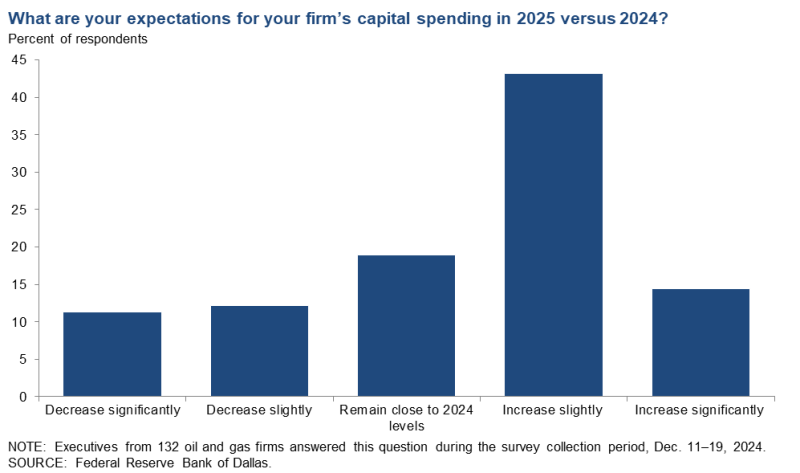Oil and gas sector spending will likely increase in the new year, but not evenly as the biggest producers look to tap the brakes.
This is according to a recent survey by the Dallas Federal Reserve Bank which showed the sector’s outlook index swung to 7.1 from -12.1 in the previous quarter, signaling cautious optimism among producers. The uncertainty index also eased, dropping to 22.4 from 26, further hinting at improving confidence in the upstream business environment
The equipment utilization index for oilfield services firms remained in negative territory but improved, moving from -20.9 in the third quarter to -4.4 in the fourth quarter, suggesting the pace of the decline slowed significantly.
The survey, which was conducted in December and includes more than 130 operators in the Barnett Shale, Eagle Ford Shale, Haynesville Shale, and Permian Basin, shows that more than half of oil and gas company executives expect their firms’ capital spending to rise in 2025 compared with 2024.
However, 19% expect spending in 2025 to remain close to 2024 levels while another 23% anticipate reductions in spending in 2025.
Most respondents expect WTI price to fall slightly to $71/bbl by the end of 2025, with 35% expecting the price to fall somewhere between $70 and $75/bbl. In 2024, the average price of WTI was $76.55/bbl.
The survey also showed that participants anticipate a Henry Hub natural gas price of $3.19/MMBtu by year-end, though almost 40% see it going higher than that.
If the prediction holds, it would mark a significant upward movement from the 2024 average price of $2.21/MMBtu, which was the lowest average annual price in inflation-adjusted dollars ever reported, according to the US Energy Information Administration.
Expectations of rising oil and gas prices may clash with the goals of US President-elect Donald Trump, who has emphasized lowering energy costs and summed up his energy policy with the slogan, «Drill, baby, drill.»
As one survey respondent from the services sector said, “’Drill, baby, drill’ will not be positive for the oilfield services space if WTI drops below $65/bbl for a substantial period.»

Capital Spending
The survey also showed that capital spending for both exploration and production (E&P) companies and service companies rose at a similar pace when compared with the prior quarter.
But when drilling down a bit more into the survey, the spending story appears to be a mixed bag.
Half of the respondents from the 14 participating large firms, classified as those producing at least 10,000 B/D, expect to maintain their capital spending or slightly increase it over 2024 levels, while the other half expected to spend less.
Approximately two-thirds of smaller producers surveyed by the Dallas Fed indicated plans to increase spending in 2025, marking a notable divergence from their larger counterparts.
Sustainability
The survey also reveals a notable difference between large and small firms on the issue of emissions mitigation.
Among the large E&P firms, 57% of executives said their firm plans to reduce carbon dioxide emissions, and 64% indicated plans to reduce methane emissions.
While most major firms are implementing plans geared toward emissions reductions and sustainability, some operators still view regulatory issues as “the biggest hindrance to [the oil and gas] business,” noted one survey respondent.
Other respondents said they are more upbeat on this point after Trump’s victory in November.
“The recent election result is changing outlooks. The new administration will lift regulations, stop subsidizing green energy, and seek [liquefied natural gas] buildouts to place more demand on natural gas,” said another unnamed respondent that works for an operator.
Executives from smaller firms indicated to the Dallas Fed that they are focused more on achieving production results and less on emissions. Among the smaller firms surveyed, 58% said they have no mitigation plans, compared with only one large E&P firm out of the 14 that responded.